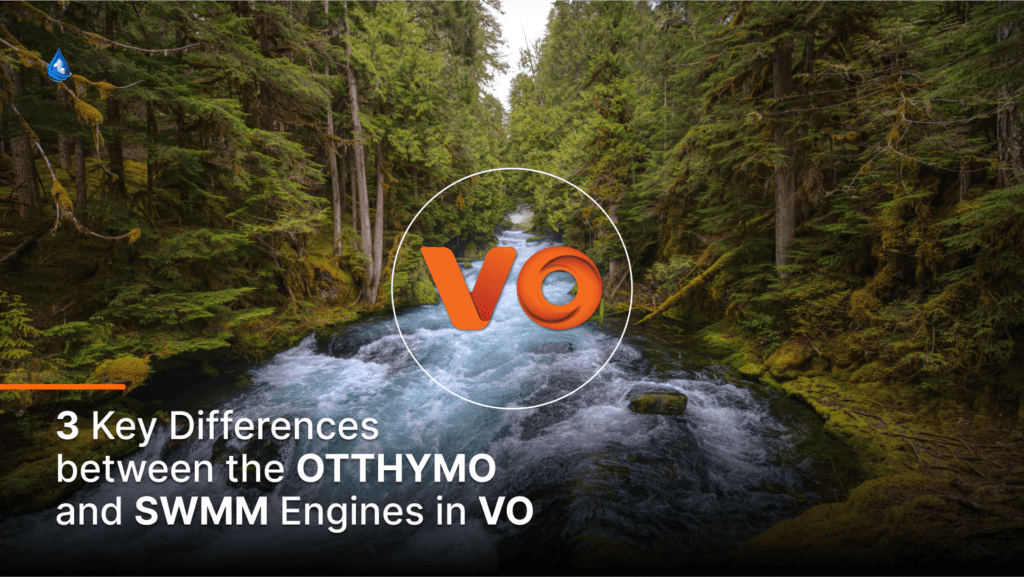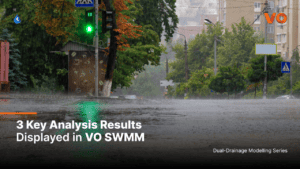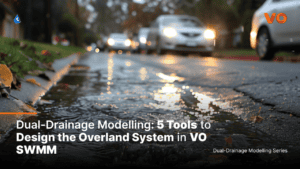
What is VO?
VO is the cutting-edge hydrologic and hydraulic modelling software used by engineers to analyze the impacts of land use and climate change on the runoff in rural and urban areas. VO assists engineers and planners in managing the capacity of drainage systems under existing and future conditions.
Originally used as a short form for “Visual OTTHYMO”, the acronym “VO” has since rebranded to refer to a single-installer software program offering licenses for two different engines. These two engines, or ‘flavours’ are OTTHYMO and SWMM.
VO OTTHYMO Background
The ‘HYMO’ portion of OTTHYMO, stands for HYdrologic MOdel, which originated as a computer program developed by Jimmy R. Williams and Roy W. Hann, Jr. for the USDA Agricultural Research Service, (ARS), United States Department of Agriculture. This was expanded in the 1970s by the USDA Agricultural Research Service (ARS) for predicting stormwater flows during storms to size channels and reservoirs. The ‘OTT’ portion of OTTHYMO, was added by Dr. Paul Wisner at the University of Ottawa. Through his research with graduate students, they expanded HYMO and improved the prediction of stormwater runoff to analyze land use changes.
The OTTHYMO engine simulates runoff using the ‘Unit Hydrograph’ concept. A Unit Hydrograph is a direct runoff hydrograph (DRH) resulting from one unit of rainfall. The unit hydrograph approach is used to estimate the total hydrograph during a storm event. The research at the University of Ottawa demonstrated using the ‘Standard Unit Hydrograph’ to match the measured flows from urbanized areas. This work simplified the analysis of urban runoff as it reduced the number of mathematical variables necessary to predict stormwater flows. This makes the OTTHYMO computational engine ideal for engineering planning and design.
VO SWMM Background
The SWMM engine is a more complex program. It was originally developed by the Water Supply and Water Resources Division of the U.S. Environmental Protection Agency’s National Risk Management Research Laboratory with assistance from the consulting firm CDM Inc. under a Cooperative Research and Development Agreement (CRADA). SWMM version 5 was produced in a joint development effort with CDM Smith Inc. The program was primarily developed to analyze drainage flows and has been heavily implemented in the simulation of urban watersheds. Its performance in strictly rural watersheds has been less frequently evaluated (https://www.chijournal.org/C372). The SWMM program is a versatile tool that, once the detailed data has been collected and populated into the system, can be used for both planning and detailed analysis and design.
The 3 key differences between the OTTHYMO and SWMM engines can be summarized in terms of primary purpose, scope and focus required, and scale.
1. Purpose
VO OTTHYMO is an engineering planning tool with design capabilities. It can be used for watershed management in rural and urban environments to quantify peak flows and volumes during storms necessary for floodplain delineation and flood protection, erosion control and water balance. It is extensively used to analyze the impacts of land development, for designing stormwater management facilities, and for open channels. It is a fast, easy and visual tool to understand a drainage system’s connectivity and function.
One distinctive feature of the OTTHYMO engine in VO is that it analyses the performance of a specific drainage element independently from other elements. The program requires inputs from climate data and flows from upstream elements before analyzing the performance independently of the conditions downstream. As such, the OTTHYMO engine does not take into account or calculate downstream back-water effects.
VO SWMM, as a full integration of the US EPA SWMM engine, is primarily a detailed analysis tool used for the design of existing drainage systems with planning capabilities. It is used primarily to assess the existing and planned capacity of hydraulic systems in urban environments. These include storm, sanitary, and combined sewers and overland flows along roads, channels, ponds, etc. The SWMM program can be used to assess the performance of individual channels under free-flow and surcharged (pressurized) conditions, as well as other energy losses during conveyance.
2. Focus
VO OTTHYMO focuses on engineering planning. It is excellent for defining pre-development flows, assessing post-development changes, and sizing stormwater management facilities, including LIDs, to limit negative impacts and/or meet targets. VO OTTHYMO is also used to establish regulatory flows and, more recently, for real-time flow forecasting. VO OTTHYMO is often used to develop stormwater management strategies at various levels: watershed, sub-watershed and sub-division levels. It contains tools for analysis of urban and rural hydrology, focusing on surface hydrology, and simulating water movement in natural environments.
VO SWMM has been intended for hydrologic and hydraulic modelling primarily in urban settings. The flow is analyzed considering energy losses in open channels and closed conduits. It accounts (solves the energy equation) for major and minor energy losses and, as such, requires specific elevations during computation. It requires more computationally – time to solve hydro-dynamic equations simultaneously across an entire drainage system (all the drainage system elements). Computational requirements can limit the size of drainage networks and/or require special computational strategies.
3. Scale
As a planning tool, VO OTTHYMO has been used to estimate flows and impacts in a broad range of areas from small areas (on-site control), to large catchment sizes (lumped catchments). It is simple to use and requires a limited number of input parameters. It can be used to analyze rainfall runoff at Site Plans and sub-divisions.
VO SWMM typically works at a more ‘micro-scale for analysis of smaller and/or individual stormwater or sanitary sewer system components. It accounts for energy losses during conveyance and evaluates backwater effects due to energy losses (i.e. surcharging, overflows, or backups). It is often used to assess hydraulic grade lines within sewers to predict basement flooding and spills.
Conclusion
VO’s OTTHYMO and SWMM engines have distinct purposes, focus areas, and scales. OTTHYMO is a versatile engineering planning tool, covering a wide range of applications and is adaptable to different scales, while SWMM specializes in detailed urban hydraulic modelling, operating at a small scale, and ideal for analyzing individual stormwater or sewer components. Your choice between OTTHYMO and SWMM depends on project-specific requirements, whether it’s broad-scale planning or detailed urban system analysis. VO provides tailored solutions to meet diverse engineering needs.
🏞️Experience the simplicity and power of VO as you create accurate models.🏙️
To download VO, click here
To request a VO license, click here





